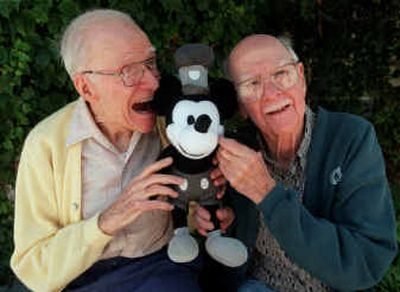Frank Thomas, key animator for Disney, dies at 92

LOS ANGELES – Frank Thomas, one of the celebrated “Nine Old Men” of Disney animation whose work set the standards by which all character animation is judged, died at his home in Flintridge, Calif., on Wednesday, three days after his 92nd birthday.
Thomas’ animation ranged from the Seven Dwarfs weeping at the heroine’s bier in “Snow White and the Seven Dwarfs” (1937) to Captain Hook dueling with Peter Pan (1953) and Lady and Tramp falling in love over a plate of spaghetti and meatballs (1955).
Born in Santa Monica on Sept. 5, 1912, Thomas studied art at Stanford University, where he met Ollie Johnston, who would become another of the Nine Old Men. The group got its name from Walt Disney as a play on the term President Franklin D. Roosevelt used to describe the Supreme Court. At the time, the veteran group of animators had barely reached middle age.
Thomas and Johnston became lifelong friends and shared numerous professional assignments. Johnston, who at 91 is the only remaining one of the group, was not available for comment.
Thomas moved to Los Angeles in 1934 to attend the Chouinard Art Institute, but a few months later joined the Disney studio, where he quickly rose through the ranks.
He did his first animation for the short “Mickey’s Elephant” in 1936, but remarked with customary humor that his first successful animation was in another Mickey Mouse short, “The Brave Little Tailor,” two years later.
Although he did animation in various shorts, Thomas is primarily known for his work on the Disney features, beginning with his animation of the Seven Dwarfs in “Snow White.”
He shared the animation of the title characters in “Pinocchio” (1940) and “Bambi” (1942) with Johnston and Milt Kahl, another of the Nine Old Men.
Thomas was responsible for some of the high points in both films: Pinocchio singing “I’ve Got No Strings” and Bambi wobbling his way across the ice with Thumper.
In 1942, he joined the 18th Air Force Base Unit, known as the First Motion Picture Unit, and spent most of World War II making military training films.
In 1946, Thomas returned to Disney, where he helped to create such memorable characters as the wicked stepmother in “Cinderella” (1950), the Queen of Hearts in “Alice in Wonderland” (1951), Captain Hook in “Peter Pan,” the title characters in “Lady and the Tramp” and the Three Good Fairies in “Sleeping Beauty” (1959).
His later work included Pongo and Perdita in “101 Dalmatians” (1961), Baloo, Mowgli and Kaa in “The Jungle Book” (1967), King John and Sir Hiss in “Robin Hood” (1973), and Bernard and Bianca in “The Rescuers” (1977).
Thomas handled some of the most emotionally complex scenes in the Disney features. When Grumpy, the self-styled “woman hater” among the dwarfs, buried his face in his hands at Snow White’s bier, audiences wept, perhaps for the first time, at the pain of an animated character.
Every parent could recognize Baloo’s awkward body language as he tried to explain why Mowgli couldn’t remain in the jungle. Thomas also conveyed Pinocchio’s wonder when the audience cheered his clumsy song and dance.
“I was looking for anything that showed he was only born last night,” he said in a 1998 interview. “He had no experience to draw on, so he had to be very wide-eyed and innocent looking.”
After retiring from the studio in 1978, Thomas and Johnston co-authored four books: “Disney Animation: The Illusion of Life” (1981), “Too Funny for Words” (1987), “Walt Disney’s Bambi: The Story and the Film” (1990) and “The Disney Villain” (1993).
The decades of work and friendship Thomas and Johnston shared were the subject of the 1995 documentary “Frank and Ollie,” produced by Thomas’ son and daughter-in-law, Theodore Thomas and Kuniko Okubo. In addition to awards from numerous animation festivals and organizations, they were honored by the Academy of the Motion Picture Arts and Sciences in 2003 when “Frank and Ollie: Drawn Together” was the subject of the Marc Davis Lecture on Animation.